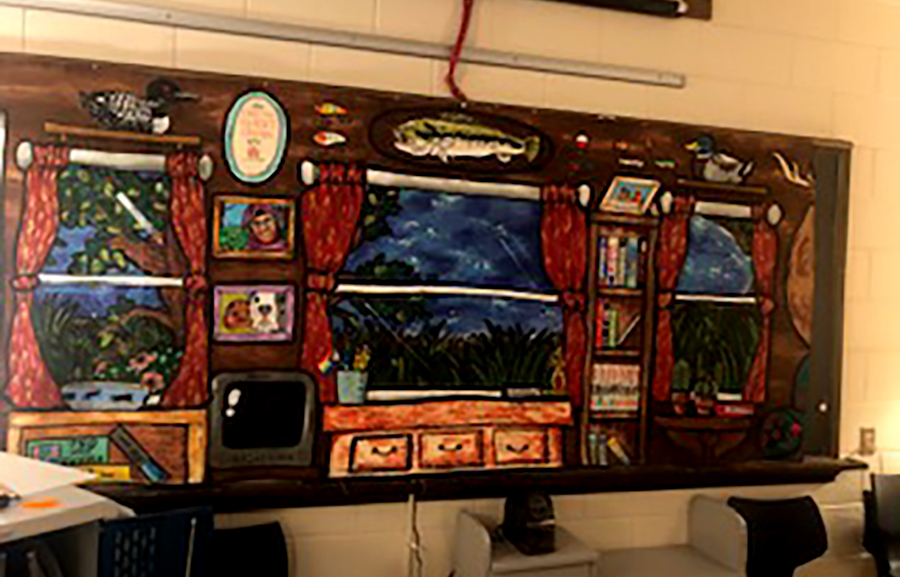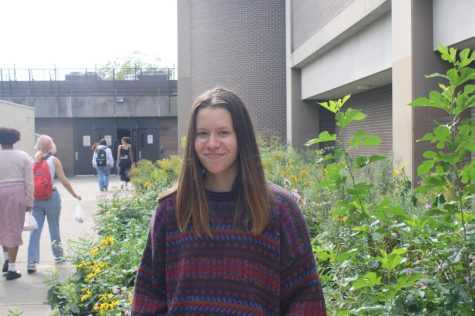Souths Architecture decreases motivation and mental health for students and staff alike
A commissioned art piece in Saroya Ireland’s room to bring up the mood of students and remind them of the outside world. Ireland’s classroom is one of many within the second floor maze that gets little to no natural sunlight. The lack of sunlight within the school has negative ramifications upon the mental health of many students and staff alike.
June 15, 2022
Coming into school in the early hours of the morning and spending almost 7 hours within the walls of a building is mentally and physically draining to students and teachers alike. On top of that, the historic architecture that delivers virtually no natural light adds to the matter. The lack of stimulating architecture, the added time to the school day and year, and the admin responses to both these factors are not only not ideal, but often affect the mental health negatively of many students and teachers.
I have struggled with a lack of light intake in my own life due to the school architecture which has a chronic lack of windows. We as humans are hardwired to spend our days outside, and the very concept of sitting at a desk staring at a screen, and listening to someone lecture for seven hours a day seems such a foreign notion, so adding high levels of fluorescent lighting to the mix definitely does not help the situation. These factors contribute to me feeling incredibly mentally drained by the end of the school year.
Many teachers are affected by the school’s architecture in both their learning style and personal mental health. A good number of teachers have classrooms within the second floor maze, which feels endless, and isolated from sunlight. One teacher that has seen an impact of architecture is ninth grade humanities teacher Saroya Ireland. Ireland believes that the building’s structure affects her student’s learning. She said, ¨It’s hard throughout the day not knowing what’s going on outside. And especially during daylight savings when you would walk outside and it’s dark.”
Many individuals suffer from seasonal affective disorder (SAD), and the lack of light intake for the day is not beneficial for them. Especially during the winter when the sun sets around 4:30, students are left with a few precious hours of daylight for themselves.
Many studies show that students consistently achieve higher academic milestones when exposed to more daylight in classrooms. Although this is not the only indicator of a student’s performance, it most definitely plays a factor. The study ‘Daylight in Schools,’ done by Pacific Gas and Electric in 1999, found that students who had more windows in their classrooms had an increase of up to 18% test scores.
Many students find these findings to be exemplified at South. “I notice that in the classrooms that have windows, students are significantly more energetic and engaged,” said junior Ingrid Noren.
Although there is no easy fix for the architectural design, and it is hard to reimagine South fully, many believe that there are some things that could be improved both by individual teacher actions and admin as well. Junior Noelle Hendricks believes there are steps of action that could be taken. “I think the teachers need to be more flexible with having class outside, and doing stuff like that. Especially when it’s warmer. Because having to be inside all day is really detrimental to mental health, and teachers need to recognize it’s often because of depression, or other mental health issues,” she said.
These symptoms are exemplified for me, feeling like there is no end in sight for when school will end. In some ways, it feels worse to be in school for all these hours when the weather is nice out, because it feels as if we are sent into some sort of time machine that spits us out in the late afternoon, with only a few short hours of daylight left. I think that the administration being cognizant of the feelings that students and teachers alike have about the architecture, and the way that affects their performance in schools by result is something that should be acknowledged more.
I understand that a long term, permanent solution to the issue at hand is likely not remarkably feasible at the given time, Although, teachers taking time to take classes outside to enjoy the bright, and fresh summer air, as well as administration building a more friendly and inviting outdoor environment around campus for students to enjoy would most certainly improve the mood of staff and students alike.






